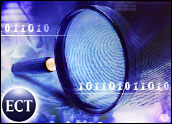
They were a staple of cloak-and-dagger drama, both fictional and real, during the Cold War and now they’re being offered to consumers as a passive means of protecting their personal property. They’re microdots.
DataDot Technology USA, of Redmond, Wash., introduced Monday a US$19.95 kit that allows consumers to attach unique microscopic identifiers — a sort of asset DNA — to their personal property to aid in its recovery if it’s stolen.
“Prior to this time, our product has been predominantly used by car manufacturers, automotive dealers and motorcycle dealers,” DataDot’s President for Distribution and Operations Stuart Cutler told TechNewsWorld.
Brainstorming Session
While working with the likes of Yamaha, Kawasaki, Harley Davidson, Audi, Nissan, Lexus and BMW, the company had an illuminating idea.
“It’s one thing to mark all the parts of a car, but often people leave their cell phone or their laptop or other items in their car,” he explained.
“What we realized was that there was a big need in the market for people to have asset DNA for their own home and electronic equipment,” he continued. “So we came out with this product designed to mark high-valuable items in the home.”
Brush on Dots
The dots in each kit are made of a high-tech polyester substrate laser etched with 50 characters of information. Consumers can register that information at a secure Web site operated by DataDot, where law enforcement officials can use it to determine the ownership of stolen property that they recover.
Suspended in a water-based liquid, the dots can be brushed on the surface of items a consumer wants to protect — cell phones, laptop computers, iPods and such — without harming the item.
The location of the dots can be seen by scanning the surface of an item with an ultraviolet, or black, light. Information on the dot can be read by using a scope with 50x magnification available at various outlets, including DataDot’s Web site and Radio Shack Stores.
Campus Market Hot
“What we tell people is to put some dots in obvious places, but then put some in less obvious places,” Cutler said.
“If a thief sees dots on there, they will try to get them off, and if they use a really sharp object, they might be able to get them off, but they will damage the item itself.
“Thieves typically want to take an item and sell it as quickly as they can,” he maintained. “They don’t want to go looking for dots or damage an item to get the technology off.”
A hot market for the kits appears to be colleges and universities. “We’ve had eight universities sign up with us in three weeks,” Cutler revealed. “They’re marking all their items across the university with the technology and making the product available to students through their bookstores.”
DataDot’s kit also includes four stickers that can be attached to items to warn off thieves with itchy fingers.
Headlight Thieves
That sticker came in handy for Detective Sgt. Charles Bryant of the West Orange Police Department in New Jersey. He discovered the label on some headlights stolen off a Lexus. “I had never seen it before,” he told TechNewsWorld.
He explained that he was able to contact DataDot from the information on the sticker and received instructions for matching the headlights to the vehicle they were stolen from.
Since his initiation to DataDot’s technology, Bryant said that he’s found it on four sets of headlights he’s recovered.
Over the last three years or so, nicking xenon headlights from some Nissan and Lexus models has become a popular pasttime for car thieves in the Northeast. The super-bright lights can cost US$1800 or more to replace.
Earlier this month, in fact, Nissan settled a lawsuit for $325,000 brought against it by the New Jersey Attorney General’s office. The suit alleged that Nissan failed to adequately warn owners of its Maxima models that the headlights were a prime target for parts robbers.





















































